
Chapter Twenty-four
FUNCTIONS OF AIR OPERATIONS IN THE CONTROL OF AIRCRAFT
A. AIR DEPARTMENT AND ITS ORGANIZATION.
B. AIR OPERATIONS.
C. SHIPS OPERATION PLAN.
D. GENERAL TACTICAL AND INTELLIGENCE DATA SHEET.
E. RECORD OF PERSONNEL, MATERIAL, AND AIRCRAFT AVAILABILITY.
F. FLY SHEETS.
G. NUMBERING AIRCRAFT.
H. STATISTICAL LOG.
I. FLY CONTROL.
J. METHODS OF AIR OPERATIONS.
K. LAUNCHING AIRCRAFT.
L. RENDEZVOUS.
M. LANDING OPERATIONS.
N. CIC RESPONSIBILITIES.
--237--

Figure 179.
Chapter 24
FUNCTIONS OF AIR OPERATIONS IN THE CONTROL OF AIRCRAFT
A. AIR DEPARTMENT AND ITS ORGANIZATION
The task of conducting air operations aboard a carrier falls to the air department and the operations department.
The functioning of the air and operations departments are the responsibility of the air officer and the operations officer under the supervision of the commanding and executive officers of the ship. Under the air officer is a group of officers each of whom is responsible for one phase of the air department work. Among these are the ACI officer, ordnance officer, flight deck officer, hangar deck officer, landing signals officer, supply officer, engineering officer, catapult officer, arresting gear officer, gasoline officer, photographic officer, and air group commander.
Under the operations officer are the CIC officers, air controllers, communication officer, Navigator, Aerological officer and air plot officer.
When a flight has been ordered, the engineering officer announces which planes are available for use. Flight and hangar deck officers decide which planes to send and how best to spot the deck. Arming and loading is accomplished by ordnance; fueling is done by the gasoline crews; photographic details are handled by photography; radio and radar personnel set up the prescribed radio frequencies; pilots are briefed on all intelligence by ACI officers; aerology supplies current weather data; and lastly the pilots for the individual planes are assigned by the air group organization.
B. AIR OPERATIONS
Air operations is the center of information where this work is coordinated and directed, and though the air department organizations on different carriers will vary somewhat in accordance with individual policies and experimentation, they all follow the same general pattern.
C. SHIP'S OPERATION PLAN
It is the responsibility of operation department administration to prepare, prior to an operation, a ship's operation plan. While similar to that issued by the task group commander, it differs from the latter in that it is a detailed description of the contribution to be made by
--239--
the individual ship and its embarked air group.
The arming plan is a supplement to this and is prepared by the air officer, air group commander and their ordnance advisors, in accordance with the task group commander's directives.
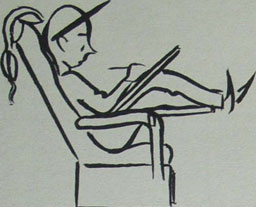
Figure 180.
D. GENERAL TACTICAL AND INTELLIGENCE DATA SHEET
A general tactical and intelligence data sheet is supplied to pilots daily by the air combat information (ACI) officer. This gives a brief outline of the day's objective, rescue information, intelligence summary, communications outline, disposition of friendly forces, etc. Just prior to take-off pilots are also briefed on "Point option" course and speed, aerological information, ships position, and last minute instructions.

Figure 181.
E. RECORD OF PERSONNEL, MATERIAL AND AIRCRAFT AVAILABILITY
Air operations is likewise charged with the
responsibility for keeping an up to date record on the status of air department personnel, material, and aircraft availability. It is essential that complete records be kept on the number of planes operational and on the number of pilots and crewmen ready to fly.
F. FLY SHEETS
Air operations also supply CIC with "fly sheets," the daily flight plan, which list aircraft numbers for each flight, names of pilots, each pilot's call designation, and/or any change that may have occurred in scheduled flight.
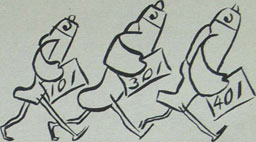
Figure 182.
G. NUMBERING AIRCRAFT
Aircraft group calls and individual number calls are established in Joint Army Navy Air Force Publication 119. Exam/pie:
0 Mission or flight leader
| 99 | Collective call for all aircraft. |
| 101 | VF (A) leader |
| 201 | VF (B) leader |
| 301 | VA (B) leader |
| 401 | VA (A) leader |
| 501 | VO leader |
| 199 | Call for all VF (A) |
| 299 | Call for all VF (B) |
| 399 | Call for all VA (B) |
| 499 | Call for all VA (A) |
| 599 | Call for all VO |
| 101-187 | Individual VF (A) calls |
| 201-287 | Individual VF (B) calls |
| 301-387 | Individual VA (B) calls |
| 401-487 | Individual VA (A) calls |
| 501-687 | Individual VO calls |
Mission number preceding all calls
--240--

Figure 183.
H. STATISTICAL LOG
Air operations also maintains a statistical log, recording number of launching and landing, daily bomb loads dropped, number of sorties, crashes, rescues, and planes lost and recovered.
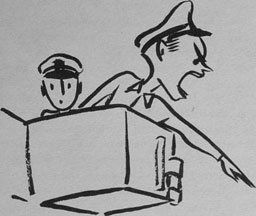
Figure 184.
I. FLY CONTROL
From fly control the air officer and the assistant air officer control the movement of all aircraft on the flight deck, all launchings and landings, use of elevators, the jettisoning of irreparably damaged planes, spotting of the deck, gassing and degassing of aircraft, etc.
J. METHODS OF AIR OPERATIONS
For conducting air operations three methods are prescribed:
ABLE--Maneuvering of the whole disposition into the wind by signal from OTC.
BAKER--Independent maneuvering generally within the screen by carriers concerned.
CHARLIE--Not a distinct method, by a procedure combining methods ABLE and BAKER with the principle air giving maximum protection to carriers operating under method BAKER. For clarity it is called method CHARLIE. In this method the carrier (s) scheduled to operate aircraft proceeds to an initial position near the downwind arc of the screen and turns into the wind as in method BAKER. At an appropriate time before the carrier passes out of the screen the commander should turn the entire remainder of the disposition by method ABLE to parallel the course of the operating carrier(s). (See USF 4 for specific details.)

Figure 185.
All carriers display one large Fox flag from each yardarm during flight operations, hoisting them at the dip when preparations are being made or during a temporary delay, two blocking when into the wind or when conducting or resuming operations.
When the ship is steady into the wind, the officer of the deck or captain on the bridge notifies fly control that the ship is ready. The air officer then orders the flight deck officer to commence air operations.
--241--
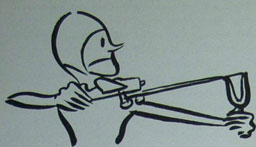
Figure 186.
K. LAUNCHING AIRCRAFT
For deck run take-off, planes are centered on the deck with sufficient run for launching, the position varying with the type of plane and its load condition. When the pilot completes check-off list and signifies readiness by a nod of the head, the starter drops his flag toward the bow, and the pilot commences take-off.
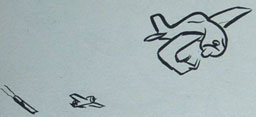
Figure 187.
L. RENDEZVOUS
When launched, the flight will rendezvous at a predetermined altitude in a prescribed sector relative to the formation axis.
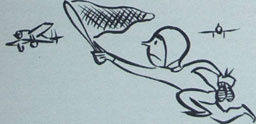
Nfvra Iff.
M. LANDING OPERATIONS
The normal landing order for returning planes is usually VF and VA, unless some unusual deck spot or condition requires that it be otherwise. Returning planes will rendezvous and remain in their own sectors (break-up sector is the same as the rendezvous sector) under the control of the group CIC officer until that officer signals "Prep Charlie." After receipt of "Prep Charlie," landing control of the air group is shifted automatically to parent carrier and break-up procedure is commenced. When signal "Charlie" is given by parent carrier, planes will begin landing aboard.
Air operations should inform CIC when landing operations are completed.
N. CIC RESPONSIBILITIES
Once air-borne the planes come under the direct control of CIC. In the event of aircraft emergencies (such as oil or gas leakage, lack of oil pressure, critically low "state," hydraulic leak, structurally damaged plane, etc.) the CIC officer should as quickly as possible ascertain the nature of the trouble and the pilot's estimation of how long he can remain airborne. CIC should inform air operations immediately and request instructions for pilot. The pilot house, flag operations, and the group CIC officer should also be notified immediately.
The decision for emergency recoveries

Figure 189.
--242--
normally lies with the OTC and/or the commanding officer of the parent ship. Authority does not rest with CIC, whose.function in such case is primarily as an intermediary between pilot and proper authority. If water landing is required, plane should land approximately 1,000 yards ahead of and slightly on the lee bow of one of the screening or plane guard destroyers. Look-outs, bridge, and all others responsible should be informed, and information regarding the expected landing is given over the primary tactical maneuvering and warning net.
--243--
Table of Contents
Previous Chapter (23)
Next Chapter (25)











